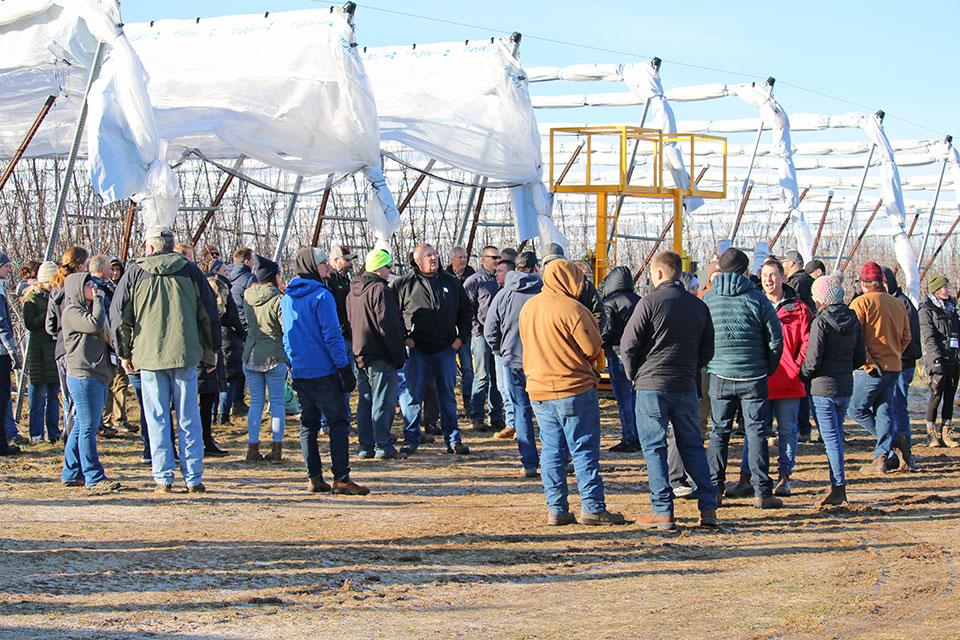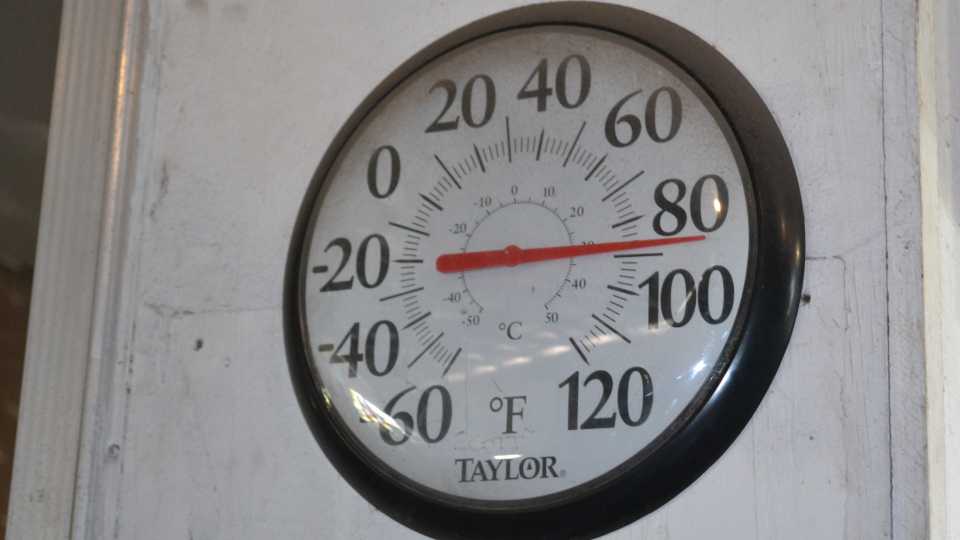How More Shield Equals More Yield For This Cherry Grower

Protective covering of mature cherry trees at Riveridge Land Co. on Michigan’s Fruit Ridge attracts a crowd of International Fruit Tree Association members. Photo by Thomas Skernivitz

Justin Finkler no longer has to sleep with one eye open. His sweet cherry farm, once at the mercy of nearby Lake Michigan, now goes to war with the elements behind a solid defense system. Protective covers and netting fully adorn 30 acres of sweet cherry at Riveridge Land Co. in Grant, MI. By 2027, the same will be said for the 40 acres of trees that were planted last year and 50 acres that are going in this season.
Finkler, the farm’s Operations Manager, could not be more content with the repeated expenditures. Without protection from the rain, vulnerability to cherry cracking is significant. The fruit either goes to waste or is harvested prematurely.
“Being able to grow any kind of program or having confidence in any kind of volume throughout the season, you have to have a cover on it,” Finkler says. “Our climate is erratic enough that you have to do some of these things as a countermeasure. It seems like there’s something every year.”
Riveridge learned as much the hard way before turning to a German manufacturer, Voen Covering Systems, in 2022. At that time, all Finkler wanted to prevent was the rain-induced cracking of his cherries.
“With us being so close to Lake Michigan in the summertime, we don’t have a lot of time to react to a rain event,” Finkler says. “You get an inch of rain within 10 days of harvest, and it can be a complete disaster. It has happened to us several times.”
In those instances, Finkler and his staff would inevitably have to pick their crop — despite its immature state — in advance of the rain.
“If you get one chance to harvest it before you get the rain coming, we usually err on the side of caution,” Finkler says. “It’s really forced our hand to not pick the best eating-quality fruit.”
LIVE AND LEARN
Having pondered protective covers and conferred with Voen as early as 2017, Riveridge began preparing existing blocks for what wound up being a 2022 transition to its present cover system. Installation took place in early spring. The learning curve was fairly steep. Tall, mature trees made the process even more difficult.
“We didn’t have some of the equipment that we needed. We tried renting some equipment; some of that stuff works OK in an outside application in the orchard, but some of it doesn’t,” Finkler says. “We were also installing the cover over the tops of trees that were already 12 to 15 foot tall. That was a challenge.”
Since then Riveridge has custom-built some of its equipment, including platforms and attachments for skid steers to handle rolls and cabling. Its new plantings, with high density as the end goal, will all be designed in V-trellis, UFO systems.
“We’re much more suited now than we were when we started,” Finkler says. “Now, when we’re planning the orchard, we’re putting the trellis in right away with the center poles to handle the cover. All we’ll have to do then is put a hardware kit on top of the pole and then cabling and then roll the cover out —much easier than trying to pound poles in around trees and all that stuff.”
BONUS BENEFITS
Row covers can alleviate far more problems than rain cracking. They potentially protect against frost, hail, wind, insects, disease, and birds.
Frost came to Michigan’s Fruit Ridge last year. Finkler’s covers alone raised the temperature 3° to 5° F, he says. Upon adding heaters to the mix, he saw an increase of 5° to 7° F. The fuel source for the heaters is wood pellets, which, according to Finkler, do not produce soot that could degrade the cover material.

Riveridge Land Co. enjoyed immediate success upon investing in bird netting in 2023 for the first time. Photo by Justin Finkler
Finkler believes vertical bird netting hung around the perimeters of the cherry blocks would have increased the temperature even further because of its wind-blocking capability. Whether that is true may be determined this spring, as Riveridge last year added netting (also made by Voen) later in the season to thwart birds.
“All of our covered acreage was bird netted last year, and it does make a significant difference as far as bird damage goes,” Finkler says. “When we were picking and packing cherries last year, there were virtually no bird pecks in the packs.”
Riveridge has yet to experience a hailstorm since installing its cover system. In any case, hail season coincides with the rainy season, meaning the covers will be enabled regardless.
“What we did last year is we actually put our covers out for frost protection in the middle of April, and then we left them all the way through harvest,” Finkler says. “We’re starting to harvest the third week of June through the third week of July, so I didn’t feel like it made a lot of sense financially to pull them back in and then pull them back out with the man-hours. I don’t know if we’ll continue doing that across all varieties on all acres. Some we’ll pull in, some we’ll put back out. We’re learning as we go here.”
Regarding high winds, while Riveridge has seen gusts in the range of 70 mph, there have been no significant issues, Finkler says.
As for insects and disease, some of the bird netting at Riveridge is small enough to discourage spotted wing drosophila (SWD), although Finkler is not targeting the insect. Likewise, the moisture-prevention aspects of the rain covers indirectly limit incidence of bacterial canker and leaf spot.
Finally, Riveridge uses its cover system to promote pollination by attracting bees to a warmer atmosphere. “If it’s a little cooler outside, if we can gain a few degrees and get the bees to work a little better, we can spread our pollen around,” Finkler says.

V-trellised sweet cherry trees accommodate protective coverings at Riveridge Land Co. in Michigan. Photo by Thomas Skernivitz
ALL ABOUT INSURANCE
Finkler believes Riveridge is the lone farm in Michigan currently covering cherries. “The Voen guys have been over here, talking to some other growers who are considering it,” he says.
Regarding cost, Voen estimates that a cover system with an eight-year lifespan will cost about $3,000 per acre per year, according to Finkler.
Labor-wise, Finkler estimates that it cost Riveridge 190-man hours per acre to build its trellis system and install the covers. To deploy and hibernate the covers each season is another 25 to 30 man-hours per acre, he says.
For interested growers, Finkler highly recommends a cover system. After dedicating the finances and man-hours to plant and care for the cherry trees, it makes little sense, he says, to wind up with a crop that cannot be brought to market. Developing a customer base without consistent supply would become impossible.
“We’ve been happy,” Finkler says. “We’ve been happy with Voen as far as their support goes, and we’ve been happy with what we’ve seen so far. We’re anxious to learn more as these orchards grow and figure out what we actually can do underneath these covers.”










